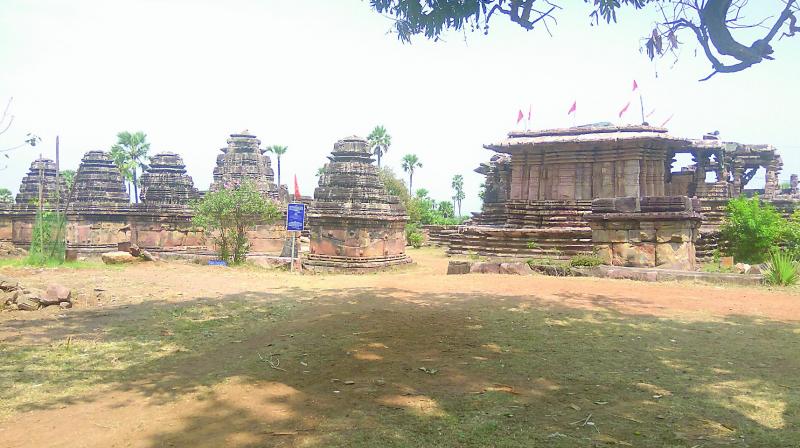Ghanapuram temples may collapse in a heap

Hyderabad: Locally known as Kota Gudulu, the Ghanapuram temples were hidden from the outside world for a long time. It was covered with sand, because this was the route the invaders took and they ignored the mound.
There is an interesting twist to this part of the story. The temples were covered by Shitab Khan. He was born Sitapathi Raju and became a foot soldier in the Bahamani Sultan Humayun Shah’s Army. As he rose in rank, the title ‘Shitab Khan’ was conferred upon him. Many texts assure us that he did not convert.
Shitab Khan is supposed to have repaired irrigation tanks and ruined temples. He saved the Kota Gudulu, but unfortunately there is no one to protect this temple now, which is close to collapsing.
The temples are under the purview of the state archaeology department. Apparently, work to repair them was started in 2008 and Rs 2 crore was sanctioned, but the contractor pulled out when the second tranche didn’t come through.
The temples are located about 65 km from Warangal, and the road is quite decent, with greenery all around. Incidentally, there are several Ghanpurs, but you have to cross Warangal and Mulugu. Kota Gudulu is in Ghanapuram village which is in Jayashankar Bhupalpally district.
The temples are 11 km from the 11th century Ramappa temple, a Shivalaya, where Lord Ramalingeswara is worshipped. The temple is named after the sculptor Ramappa, perhaps the only one to be named after a craftsman who built it.
The Ghanapuram temples, a group of 22, were constructed by King Ganapatideva of the Kakatiya dynasty, which ruled Warangal from 1199-1260. Since these temples were constructed during this period there is a lot of similarity with the Ramappa temple.
The Kakatiyas’ love for culture and design comes through in most of the architecture. In ruins, these structures attract attention with their effort to stand tall in spite of time and nature.
Though these structures are in deep ruin and some of them look like they might fall any time, the detailing is what attracts you. Flowers, women in abhinaya poses, a line of elephants, serpents, everything still stand out after so many centuries.
There are a number of jalis and a granite door frame. Within the complex lie two mandapams, one with a roof but resting on pillars and one which has collapsed. The porches or more so their roofs are superb and different.
This is Kakatiya art at its best and the rock-cut friezes on the walls, ceilings and gateways have been worth spending time over. Flowers and figures have been effortlessly carved out of solid granite. Then there are all those fallen pieces with the department numbers noted on them.
The main Shiva temple, the Sri Bhavani Sahita Ghanapeshwaralayam, is in a working condition. The sanctum floods when it rains but puja is conducted for the red polished Shiva Lingam.
The faithful Nandi sits in front of his Lord, with his nose chopped. History has it that this temple was damaged during the invasion of Giyasuddin Tughlaq in 1323.
The Shiva temple faces the north and there are entrances from all three sides, though only one is approachable. With tall steps, there is the fear that if you take support from one pillar, you might dislodge the others. Built on a high star-shaped platform, the centre portion of the temple is open to nature. There are many small Shiva temples, five on one side of the entrance and two on the other. Small, but with great design.
Reaching this temple and looking around might take quite a bit of time. Since you are coming from Warangal you could check out the fort, Bhadrakali temple and Thousand Pillar temple. And then the Ramappa temple too.
The roads are fairly decent, but construction work is still going on and that causes a few problems. Because of which driving itself takes some time.
While the locals show total disinterest in the heritage site, the ambience soon catches up.
A toddy tapper quickly climbs up a tree to collect the booty, for the season has started.
One is given to understand that this is ‘Parupu taadi’ and if you want to partake in it, one must try it in a place where a toilet is available, for it has a tendency to clean the stomach.

